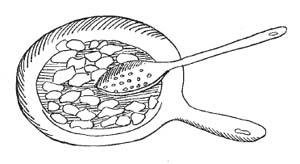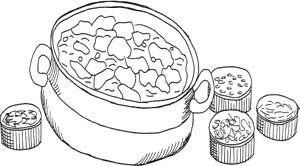Nourishing Traditions: The Cookbook That Challenges Politically Correct Nutrition and The... (81 page)
Authors: Sally Fallon,Pat Connolly,Phd. Mary G. Enig
Tags: #Non-Fiction, #Reference, #Science, #Health
Michael DeBakey, the world renowned heart surgeon from Houston who has devoted extensive research into the cholesterol-coronary disease theory, states that out of every ten people in the United States who have atherosclerotic heart disease that only three or four of these ten have high cholesterol levels; this is approximately the identical rate of elevated cholesterol found in the general population. His comment: "If you say cholesterol is the cause, how do you explain the other 60 percent to 70 percent with heart disease who don't have a high cholesterol?" De Bakey made an analysis of cholesterol levels from usual hospital laboratory analyses of 1,700 patients with atherosclerotic disease and found that there was no positive or definitive relationship or correlation between serum cholesterol levels and the extent or nature of atherosclerotic disease. H. Leon Abrams
Vegetarianism: An Anthropological/ Nutritional Evaluation

CHICKEN CURRY
Serves 6
meat from 2 cooked chickens, cut up (reserved from making stock,
chicken stock
)about 3 tablespoons
clarified butter2 medium onions, finely chopped
2 tablespoons turmeric
1 tablespoon ground fenugreek seeds
1 teaspoon ground cumin
¼ teaspoon cayenne pepper
½ teaspoon ground cloves
1 teaspoon ground coriander
1 teaspoon ground cardamom
2-3 cups
chicken stockjuice of 1-2 lemons
2 cloves garlic, peeled and mashed
1 cup
piima cream
,
creme fraiche
, 1 can whole coconut milk or 7 ounces creamed coconut (see
About Coconut Products
)sea salt
Saute onions until soft in clarified butter. Add spices and saute, stirring, for several minutes. Add chicken stock and lemon juice and bring to a boil. Stir in garlic, chicken and cream. Simmer, uncovered, for about 15 minutes, stirring frequently, until sauce is reduced and thickened. Stir in chicken and season to taste. Serve with traditional curry garnishes such as chopped green onions, chopped
crispy peanuts
,
dried sweetened coconut meat
,
raisin chutney
and
fruit chutney
.
Obtaining adequate fat was a great challenge for the Australian Aborigine, living in a hot, dry climate. They were close observers of nature and knew just when certain animals were at their fattest. For example, kangaroos were fat when the fern leaf wattle was in flower; possums when the apple tree was in bloom. Other signs indicated when the carpet snake, kangaroo rat, mussels, oysters, turtles and eels were fat and at their best. Except in times of drought or famine, the Aborigine rejected kangaroos that were too lean—they were not worth carrying back to camp. During periods of abundance "animals were slaughtered ruthlessly, and only the best and fattest parts of the killed game were eaten." Favorite foods were fat from the intestines of marsupials and from emus. Highly saturated kidney fat from the possum was often eaten raw. The dugong, a large seagoing mammal, was another source of fat available to natives on the coasts.
Other sources of fat included eggs—from both birds and reptiles—and a great variety of insects. Chief among them was the witchety grub, or moth larva, found in rotting trunks of trees. These succulent treats—often over six inches long—were eaten both raw and cooked. Fat content of the dried grub is as high as 67 percent of calories. The green tree ant was another source of valuable fat, with a fat-to-protein ration of about twelve to one. Another important seasonal food in some parts of the country was the begong moth. The moths were knocked off rock walls on which they gathered in large numbers, or smoked out of caves or crevices. They were roasted on the spot or ground up for future use. Moth abdomens are the size of a small peanut and are rich in fat.
Nasty, Brutish and Short?

CHICKEN WITH WALNUTS
(Fesenjan)
Serves 6-8
meat from 2 cooked chickens, cut up (reserved from making stock,
chicken stock
)2 cups crispy walnuts (
Crispy Pecans
)2-3 cups
chicken stock2-4 tablespoons Rapadura (see
Guide to Natural Sweeteners
)12 ounces concentrated pomegranate juice, or
1
/
3
cup pomegranate "molasses" (available at Middle Eastern markets)sea salt and pepper
This delicious recipe comes from Persia. Place walnuts in food processor and grind to a paste. Mix with stock, concentrated pomegranate juice and Rapadura. (Note: Use the larger amount of stock if using pomegranate "molasses.") Heat up slowly and simmer for about ½ hour. Season to taste. Add chicken meat to sauce and simmer about 5 minutes or until chicken is warmed through. Serve with
basic brown rice
.
Because table salt comes from the same batch as vacuum-refined industrial salt, it is treated with caustic soda or lime to remove all traces of magnesium salts. These vital magnesium salts are not taken out because they keep the salt from flowing out of the dispenser spout, it is because they bring in more profits on the chemical market. Yet these magnesium salts are a very necessary part of the food salt and fill important biological and therapeutic roles. Further, to prevent any moisture from being reabsorbed, salt refiners now add alumino-silicate of sodium or yellow prussiate of soda as desiccants plus different bleaches to the final salt formula. But since table salt, chemically treated in this way, will no longer combine with human body fluid, it invariably causes severe problems of edema (water retention) and several other health disturbances. The fear of salt that we witness today and the virtual ban on consuming products with a high sodium content is a matter of serious concern to biologists. Salt-free diets can cause salt starvation, which is a stark reality of our modern world, but it is actually a starvation of macro-and trace minerals, a biological deficiency that refined sodium chloride alone cannot correct. Jacques DeLangre
Seasalt's Hidden Powers
CHICKEN SUPREME
Serves 6
meat from 2 cooked chickens, cut up (reserved from making
chicken stock
)1 pound fresh mushrooms, washed, dried and sliced
4 tablespoons shallots, chopped
2 tablespoons butter
2 tablespoons extra virgin olive oil
½ cup dry white wine
2 cups
chicken stock1 cup
piima cream
or
creme fraiche1 tablespoon gelatin (See
Sources
), optionalsea salt and pepper
In a heavy skillet, saute mushrooms in two or three batches until golden. Reserve. Add more butter and olive oil and saute shallots until soft. Add wine, stock and optional gelatin, bring to a boil and cook, uncovered, until stock has reduced to about one-third. Add cream and reduce further. Stir in chicken meat and mushrooms and simmer about 5 minutes. Season to taste. Serve with
basic brown rice
or as a filling in
buckwheat crepes
.
Myth: | A vegetarian diet will protect you against atherosclerosis. |
Truth: | The International Atherosclerosis Project found that vegetarians had just as much atherosclerosis as meat eaters. ( |
CHICKEN GUMBO
Serves 8
meat from 2 cooked chickens, cut up (reserved from making
chicken stock
)2 tablespoons butter
2 tablespoons extra virgin olive oil
2 large onions, chopped
1 red pepper, seeded and chopped
1 green pepper, seeded and chopped
½ cup tomato paste
2-4 cups
chicken stock2 cloves garlic, crushed
1 teaspoon dried basil
1 teaspoon dried oregano
1 teaspoon green peppercorns, crushed
2-3 tomatoes, peeled, seeded and chopped
sea salt
1 tablespoon fil
e
powder (available in gourmet markets and specialty shops)
To peel tomatoes, see
Kitchen Tips and Hints
. Saute onions and peppers in butter and olive oil until soft. Add tomato paste and chicken broth and bring to a boil. Skim, reduce to a simmer, and add chicken meat and seasonings. Simmer about 1 hour, uncovered, stirring occasionally. About 10 minutes before serving, stir in tomatoes and season to taste. Remove from heat and stir in file powder. Serve with
basic brown rice
or
wild rice
.
The penalties for using a synthetic, imitation, chemically embalmed substitute for butter seem to be quite drastic. Some appear to be: (1) Sexual castration for the growing child, in more or less degree, with oversized females fatter and taller than the boys. (Remember, meat animals are castrated for the purpose of making them fat.) (2) Loss of ability to maintain calcified structure, such as teeth and bones. Dental caries, pyorrhea, arthritis, etc., would be logical end results that would inevitably follow, especially in view of the added influence of other refined and devitalized foods. Dr. Price's experience in curing arthritis, dental diseases and lowered resistance with good butter directly bears out this conclusion. (3) Evidence is accumulating to show that multiple sclerosis is a result of deficiencies in which vitamin E complex (as found in butter) is vitally involved. Further, vitamin E is now found to be a remedy for the disorders of menopause, showing how these deficiency diseases follow their victim through life. Royal Lee, DDS
Butter, Vitamin E and the "X" Factor of Dr. Price